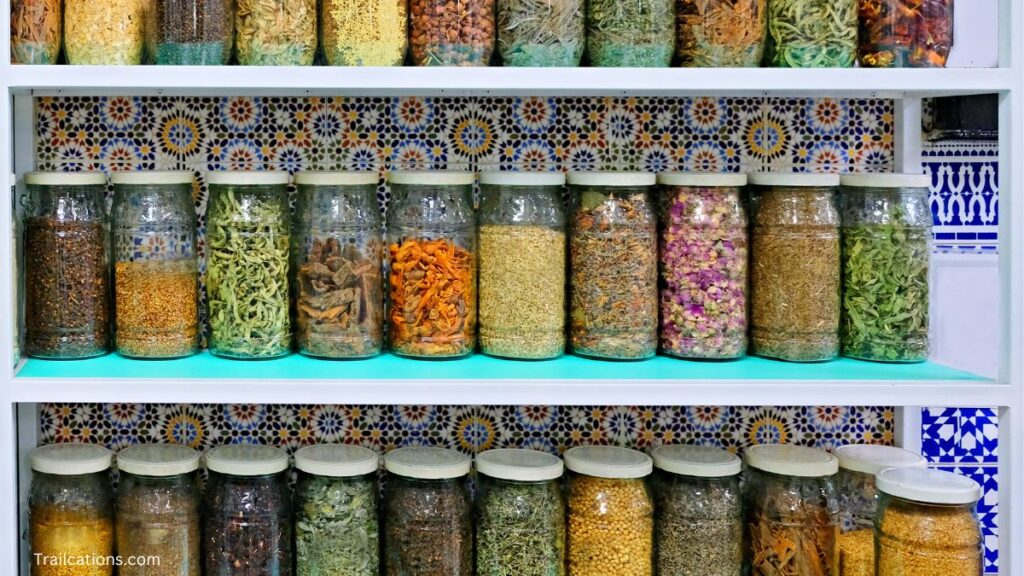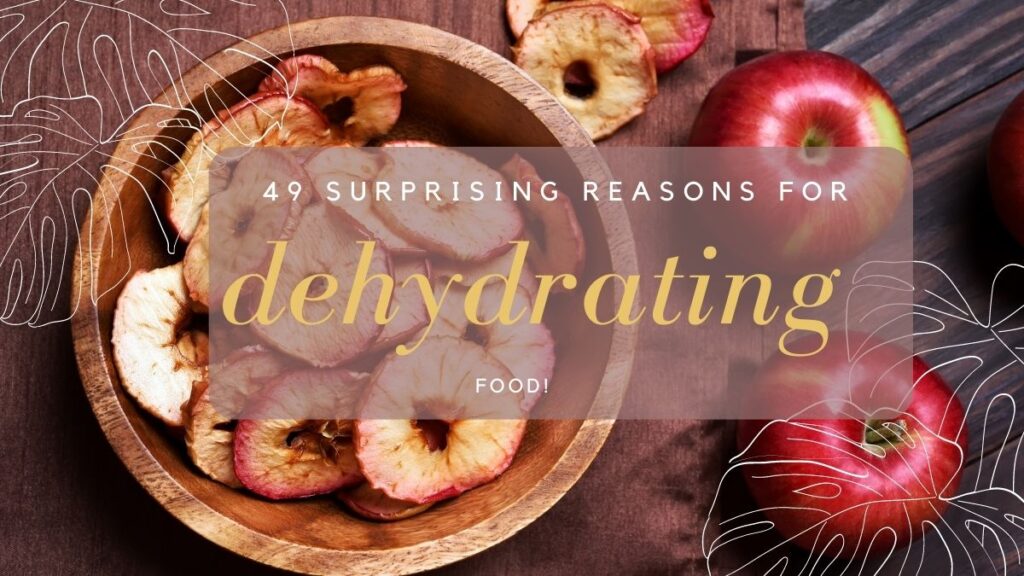Say goodbye to preservatives and expensive backpacking meals! The benefits of dehydrating your own food will save you time, money and your health.
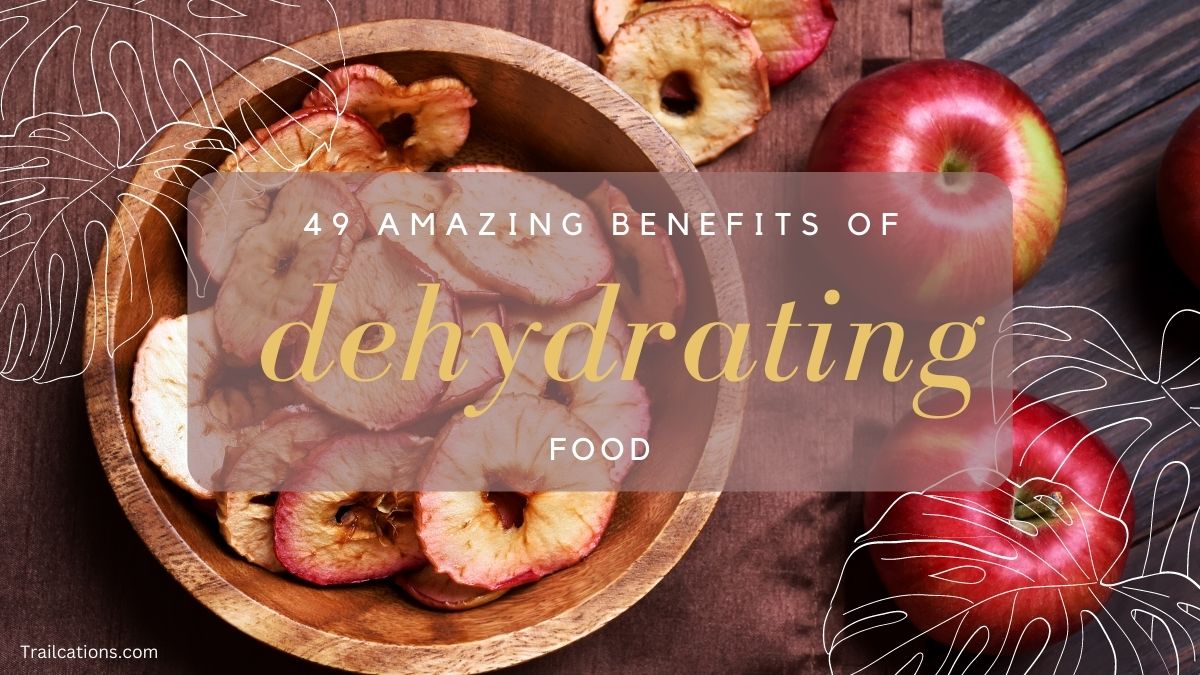
The benefits of dehydrating food for backpacking and at home
I’ve been obsessed with the benefits of dehydrating food since my first thru-hike on the iconic 2,200-mile-long Appalachian Trail. Many adventures later, my love for dehydrated food has carried over into my daily life, providing a pantry full of delicious ingredients and nutritious “just-add-water” meals for when I’m just too busy to prepare a full meal for my family.
The Problem: How to eat healthy on budget?
Years ago, I was planning a once–in-a-lifetime Appalachian Trail (AT) thru-hike. If I budgeted correctly, I could spend six months walking from Georgia to Maine and achieve a lifelong dream of mine. I wanted to eat healthy on the trail but my small budget was more in the range of cheap, shelf-stable food instead of fancy name brand backpacking meals. Cheap food in America usually skews towards carbohydrate heavy items like artificially flavored noodles, refined grains and sugary preservative-filled bars and pastries. You know, the stuff that makes you feel instantly energized but then just as quickly makes you crash.
How was I going to walk thousands of miles on essentially empty calories? I felt like my body was going to break down from lack of vitamins and protein just thinking about it.

I was daydreaming about my hiking food conundrum when a coworker stopped by and offered me some homemade venison jerky. Thanking him, I commented on how he must’ve spent a fortune making it since storebought jerky was so expensive.
My coworker happily started talking about his dehydrator and how much money he’d saved over the years using it. He dried extra produce from his fridge and garden, made jerky from animals he raised or hunted and created dehydrated meals for camping trips. The benefits of dehydrating your own food blew my mind.
All of a sudden it clicked. Could I eat healthy and stick to my small thru-hiking budget if I put in a little effort into dehydrating my own food? The answer turned out to be “YES!”
The Surprising Benefits of Dehydrating My Own Food
Buying a secondhand dehydrator allowed me to stretch my wallet and have a more nutritious diet. I soon found out that there were so many good reasons to dehydrate my own food. On the AT, I supplemented my instant noodles and mashed potatoes with healthy veggies. My oatmeal and grits had home dried fruit and spices. I substituted sugary store bought granola bars with delicious, calorie dense dehydrated raw food bars.
Did I mention my dried meals and snacks also turned out to be delicious? On my Appalachian Trail thru-hike, other hikers even offered money to buy my home dried food off me! It’s just that good.

Dehydrating Food Saves Money
One of the best benefits of dehydrating my own food has been that I’ve saved thousands of dollars over the years on outdoor adventure trips. When I can’t eat all the produce in my fridge or from my garden plot, or when there’s a really good deal at the store, I pull out my dehydrator and dry the extra food at its peak ripeness. My dehydrator works all year round at a cost of less than $1 per every 10 hours. The benefits of dehydrating food keep surprising me. For a fraction of the price, my food dehydrator has helped me eat like royalty both at home and on the trail.
One of the reasons why I use a dehydrator is that it’s so easy to make cheap, nutrient rich, preservative free foods that actually taste delicious.
I’ve shared dehydrated snacks, meals and even beautiful mason jar cocktail kits with some of the pickiest eaters and self-proclaimed foodies. Friends and family are always surprised to discover how flavorful home dried food tastes. The flavors and portability of DIY dehydrated snacks and meals are absolutely wonderful for both outdoor adventures and at home. What really sold me on drying my own food was not only how easy it is and how healthy the food is, but also how much money you can save.
There are so many fantastic benefits and reasons for dehydrating your own food.
Here’s a few of my favorites that I wanted to share with you.
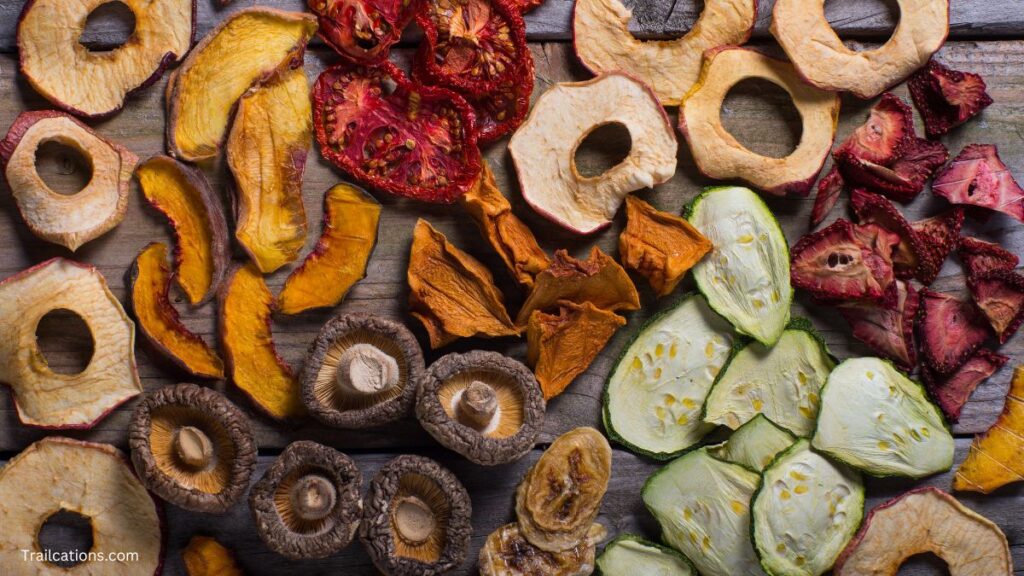
1. Food dehydrating is simple and you don’t need a lot of fancy equipment to get started.
Basic food dehydrators can be easily found on Facebook Marketplace, Craigslist and eBay. Some foods can even be dried in your oven, air fryer, or microwave! For our carbon footprint conscious friends, hanging herbs indoors to dry is very easy. Fruits and veggies tend to dry better using eco-friendly outdoor drying methods like solar dryers or hanging mesh baskets in the sun, both of which are easily DIYed or purchased. Plus there are tons of recipes online that provide directions for dehydrating every type of food you could ever imagine!
2. Dehydrating retains almost all the nutrients, minerals, vitamins and fiber in a food.
Drying is the best method of food preservation for keeping the nutrients intact in comparison to nutrient-zapping processes like canning and freezing. The only disadvantage of dehydrating food is that up to 90% of the Vitamin C can be lost due to the natural drying process. Luckily you can quickly fix this issue by dipping your produce in citrus juice or ascorbic acid (aka Vitamin C powder mixed in water) before dehydrating. Bonus: Citrus juice and Vitamin C dips are proven to keep away bad bacteria growth and even prolong the storage life of dried food!
3. Properly dehydrated food lasts years (or even decades).
One of the benefits of dehydrating your food is that it lasts 5 to 10 times longer than other food preservation methods like freezing or canning. How long a dehydrated food will last depends on how well it is stored. At room temperature in an airtight container or plastic bag, dehydrated produce lasts up to 1 year or more. Vacuum seal the container, add an oxygen absorbing packet, place it in a cool, dark environment and you could see your dried food last upwards of 10 to 25 years!
4. Zero additives! You control exactly what goes into your dehydrated food.
Home dried food has no hard-to-pronounce preservatives, additives or chemicals like what is found in dried food purchased from the store. A lot of commercial dried food also contains unhealthy amounts of extra salt and sugars to make lower quality ingredients taste better. Break the preservative cycle and save yourself from future health issues like hypertension and Type II diabetes. Home dried food all the way, baby!
5. Set the temperature dial and forget it.
Drying food doesn’t require a lot of monitoring which means it’s perfect for someone with a busy lifestyle. You prep the food, stick it in your dehydrator, turn it on and walk away. One of the benefits of dehydrating food is that it’s perfect to start the dehydrator at the beginning of your day, take care of business and come back at the end of the day to put the dried food away. Lucky for us busy people, you can’t “over dry” your food!
6. Removing the water from a food stops bad bacteria, fungi and mold from growing.
Dehydrating is one of the safest and healthiest methods of preserving food. Dried goods can last for years or even decades when preserved properly. Basic food safety practices like washing your hands, sanitizing your storage containers and making sure meat internal temperatures reach 160℉/71℃ go a long way. Additionally, it’s recommended to pretreat some fruit and vegetables by blanching them in boiling water or dipping them in a citrus or Vitamin C solution before drying.
7. Dried food offers something new in the healthy snacks department.
From homemade fruit and nut trail mix to creative veggie chips to nearly infinite combinations of DIY pureed produce roll ups, your family will never get bored of home dried snacks. For instance, a bulk sized can of applesauce can be combined with spices like cinnamon or other pureed fruit like strawberries, peaches or kiwis. It’s easy to dehydrate these fruit mixtures and create dozens of flavors of easy, portable fruit leather snacks for on the go.

8. No more worrying about allergy or dietary restrictions when you make your own dehydrated meals and snacks.
You control exactly what goes into your home dried food. Say goodbye to frantic grocery store ingredients research projects to decipher allergen containing ingredients. And say hello to more free time and peace of mind knowing you’re eating 100% au natural!
9. A benefit of dehydrating food is that it takes up far less space than fresh, frozen or canned food.
Vacuum sealed bags and jars help shrink the volume even further, especially when indoor real estate is limited like in an apartment or dorm room. On average, dehydrated food only has about 1/15 the bulk of the original food item. It’s the perfect food option for outdoor adventurers looking to go ultralight!
10. Dehydrating fruits and veggies concentrates the flavor of a food.
Each slice of dried food becomes an intense flavor bomb as the water is removed. Fruit becomes sweeter, mushrooms become mushroomier, veggies become so savory that even picky eaters might change their minds! Some of the top restaurants in the world regularly dehydrate food to concentrate flavors and take their dishes to the next level. Do they give Michelin Stars for backpacking meals?
11. You’ll also get a more effective energy boost from dried food vs. other snacks because dehydrating concentrates the calories and natural nutrient content.
Besides concentrating the flavor, dehydrating also packs a punch in the nutrient and calorie department. Compared to the same weight of fresh, frozen or canned foods, you get significantly more of everything good (vitamins, minerals, fiber) with dehydrated food. Get those extra trail miles in without the crash of highly processed foods by chowing down on some nutrient-dense DIY dehydrated trail mixes, jerky, granola bars or raw food. Chalk another point up on the scoreboard for reasons to dehydrate your own food!
12. Don’t throw away your wilting produce – dehydrate it!
Dehydrating is a great way to clean out your refrigerator without having to waste food or money. So what if your spinach is a little wilted or your carrots aren’t looking as plump as when you first bought them? When you dry food, it becomes tiny, hard and shriveled up. Plainly speaking, dehydrated produce isn’t likely to win any beauty contests anytime soon! However, being wrinkled up doesn’t mean your dried food won’t taste great. In fact, drying food only intensifies the lovely natural flavors. As long as the fresh produce isn’t slimy or rotten, cut those blemishes out and stick your forgotten fridge leftovers in the dehydrator to give them new life. You’re not only saving some cash – you’re also likely saving that food from a landfill.
13. Buy or grow fresh foods in bulk and store them for years without the use of electricity or freezer burn.
Power outages, natural disasters and currency inflation are no longer as problematic for those with a fully stocked pantry of dehydrated food. Whether you’re a family looking to save some money, a doomsday prepper growing their stockpiles or an adventurer preparing for a long trail, it’s always a help to have healthy, delicious rations stored without having to rely on the grid.
14. Dried food is super lightweight, compact and portable.
One of the benefits of dehydrate food is that it’s perfect for ultralight outdoor adventures where carrying extra weight is a concern. Save some money and pack space with dried food on your next hiking, thru-hiking, bikepacking, paddling, camping and backpacking adventures. Whether you’re cooking for a trail maintenance crew, a family camping trip or just for one hungry thru-hiker, a major benefit of dehydrated food is that it’s shelf stable, durable and light enough to pack out to the backcountry. Fun fact: On average dried produce weighs 70-94% less than its fresh counterparts and only takes up about 5-10% of the space!

15. Cooking for a large group at home or on the trail is made so much easier with dehydrated food.
With lots of people comes lots of gear and supplies needed to make meals. Save some space, pack weight and cooking prep time by bringing home dried ingredients, snacks and even entire meals with you for camping group trips. All the prep work is done at home – slicing, dicing, peeling, etc. – all you have to do is add water! Blanching or steaming veggies before dehydrating them will also speed up the rehydration process. This means more time for relaxing, campfire storytelling and quality family time. Whether you’re on a family camping vacation, guiding a backcountry expedition or trying to make a quick meal for the kids at home, dehydrated food is the perfect way to feed a big group.
16. Minimal work is required to dehydrate food.
Unlike the labor intensive process of canning food, one of the benefits of dehydrating food is how easy and quick it is to do. Prepare the food like normal (wash, peel, slice), lay the food on your drying racks, turn the dehydrator temp dial and walk away! It’s impossible to “over dry” most foods so feel free to turn your dehydrator on and go about your day.
17. Properly dried food doesn’t spoil.
Dehydrated food has such a long shelf life because you remove all of the water used by bacteria, fungi and enzymes that cause food to rot and spoil. On average, properly stored vacuum sealed dried food lasts about 5 years. That’s about 3 years longer than canned food and 4 years longer than frozen food! If you’re very diligent about processing and storing your dried ingredients, some dehydrated foods can last upwards of 25 years. Some good ways to extend shelf life are pretreating your food, vacuum sealing, double bagging, using oxygen absorbers and storing in a cool, dry place.
18. For stoveless backpackers and thru-hikers looking to go ultra ultralight, dehydrating foods is a game changer.
As many stoveless backpackers know, some foods require cooking and are not good candidates for stoveless meals: rice, whole beans, most pastas, lentils and quinoa. This may sound out of the box but before your backpacking or thru-hiking trips, try first cooking or partially cooking your stoveless staples then dehydrating them. By the time you hit the trail, the cooking part is already taken care of – all you have to do is package up your food and add water when you’re hungry. Dehydrating opens up a whole new world of meal options to the savvy stoveless hiker!
19. Pretreating your dried foods with citrus juice or blanching extends shelf life, improves appearance and allows for quicker rehydration times.
Research studies show that pretreating foods prior to dehydration stops long term growth of bad bacteria. It also prevents natural nutrient losses occurring from the drying process. Pretreatment is as simple as dipping your foods in a citrus juice or Vitamin C (ascorbic acid) solution. Blanching or steaming certain foods prior to dehydrating also shortens the dehydrating times required and also how long it takes to rehydrate the food while cooking. Blanching or pretreatment solutions can also prevent the natural discoloration on produce that occurs from oxygen exposure.
20. Home dried foods have fewer preservatives than MREs and most commercial backpacking meals.
If you’ve ever had the good fortune to survive off Meals Ready to Eat (MREs) on a military deployment, you understand that the high levels of sodium and preservatives in those things will wreak havoc on your digestive system. Many store bought backpacking or instant meals also have high levels of preservatives, sodium and sugars that can be unhealthy in large quantities. One of the benefits of dehydrating your own food is that you know exactly what goes into your food. Home dried food gives you the freedom to avoid potentially health damaging preservatives and issues like hypertension and Type II diabetes.
21. No special equipment is needed to test your dried food for doneness.
For meat or jerky, use a basic meat thermometer to make sure internal temperatures are high enough to meet food safety standards. For fruits, vegetables, herbs and grains you can use the “Sight, Sound, Touch” test. Sight: Food looks brittle or leathery and has no signs of moisture. Sound: Snaps or crunches when broken, tears like paper or makes clicking noise when dropped (think pebble hitting a hard surface). Touch: Feels dry, hard, not sticky; tears, crumbles or shatters. High sugar foods will be leathery and bendable but don’t stick together when squeezed.
22. Elevate your flavor game with dehydrated pantry powders, seasonings and spices.
We are obsessed with drying ingredients and grinding them into powders to take our meals to the next level. Home dried herbs and spices are great ways to save money but you can also create delicious flavored powders from roots, veggies, fruits and mushrooms. The dehydrated and powdered forms of ingredients like kimchi, sauerkraut, caramelized onions, vinegar, sriracha and miso are surprisingly delicious. Combining some of these staple powders into delicious seasoning mixes and flavored salts will ensure you’ll never have boring meals again.

23. Backcountry cocktails made from dried ingredients means it’s five o’clock somewhere (but especially around the campfire)!
One of our favorite benefits of dehydrating food is that dried ingredients are so versatile for making your own cocktail recipes. Whole dried fruit can be rehydrated in alcohol, wine, seltzers or beer. Ground dried ingredients can be mixed together to create a homemade cocktail mix to add to packed out alcohol. Our current favorite experiment is alcoholic fruit leathers. Unlike cooking, the dehydrator keeps the temperatures low enough that alcohol doesn’t boil away. Just make sure to keep these fruit roll-ups for adults only! Whether you’re rehydrating dried fruit in wine to make a refreshing campfire sangria, packing out homemade under-the-stars margarita mix (complete with a DIY flavored salt for the rim) or snacking on a highly portable adult fruit roll-up in the wilderness, your dehydrator will take your cocktail game to the next level.
24. An important benefit of dehydrating food is that the preservation process makes the food completely safe to eat.
Bad bacteria, mold and enzymes that cause food to spoil and rot all need water to operate. When that water is removed by the dehydrating process, microorganisms cannot grow causing the food to safely become preserved. Research shows that dipping food in a citrus or Vitamin C solution prior to dehydrating helps extend shelf life by making it even harder for bad bacteria to grow. When properly stored, a dehydrated food is safe to eat for many years or even decades!
25. An electric dehydrator with a fan and temperature dial precisely dries food and is on average 5-10 times faster than air drying.
It can take several days to dry your food outside in a solar dryer or hanging mesh baskets. At night you have to bring in the food to avoid dew collecting and hungry animals. An electric dehydrator only takes a few hours to dry your food and can be put on a counter or in a locked room to avoid curious pets. The fan on an electric dehydrator evenly dries your food instead of relying on air currents. The temperature can be set low enough to dry delicate herbs or high enough to meet food safety requirements for jerky, seafood and meats. With a solar or air dryer, you are at the mercy of the weather and air currents to heat and dry your food.
26. You can dehydrate almost any fruit, veggie, grain, seafood, meat or meat alternative.
It is truly amazing the variety of foods you can dehydrate! Great ingredients for drying are root veggies, greens, apples, stone fruits, lean meat, canned foods, frozen produce, etc. Some ingredients are just “okay” for dehydrating because they are really watery and don’t have much flavor like lettuce, cabbage and certain melons. Stay away from drying anything that is oily, dairy based, avocados, eggs or has has a high fat content like fatty fish (ex: salmon). Avoid drying meat with a fat ratio below 90/10 as the oils will go rancid over time.
27. Dehydrating is pretty much foolproof because you can’t “over dry” food.
This particular benefit of dehydrating food is often a big selling point for beginners. If you’re not quite sure that your food is dry enough, there is no harm in letting it continue drying in your dehydrator for another hour or two. You definitely can “under dry” food where the remaining water allows bad bacteria, mold and enzymes to spoil your food. To check if your food is dry enough, use the “Sight, Sound, Touch” tests combined with conditioning tests. Condtioning Test: Place your dried food in clear jars or bags for a couple days to see if condensation forms. If you see moisture after a day or two, put the whole batch of food back in the dehydrator until it’s dry.
28. Dry what’s currently in season to take advantage of the best produce prices.
Something is always in season which means bargains. Besides the grocery store, other great places to find a deal are farmer’s markets, fruit stands, food co-ops and pick-your-own-produce farms. Take advantage of harvest time bargains by bulk drying food during its peak produce season. You can enjoy winter citrus, spring greens, summer tomatoes and autumn apples all year round without having to break the bank. For our avid gardener friends, one of the benefits of dehydrating food is that you can easily preserve all that extra garden produce.
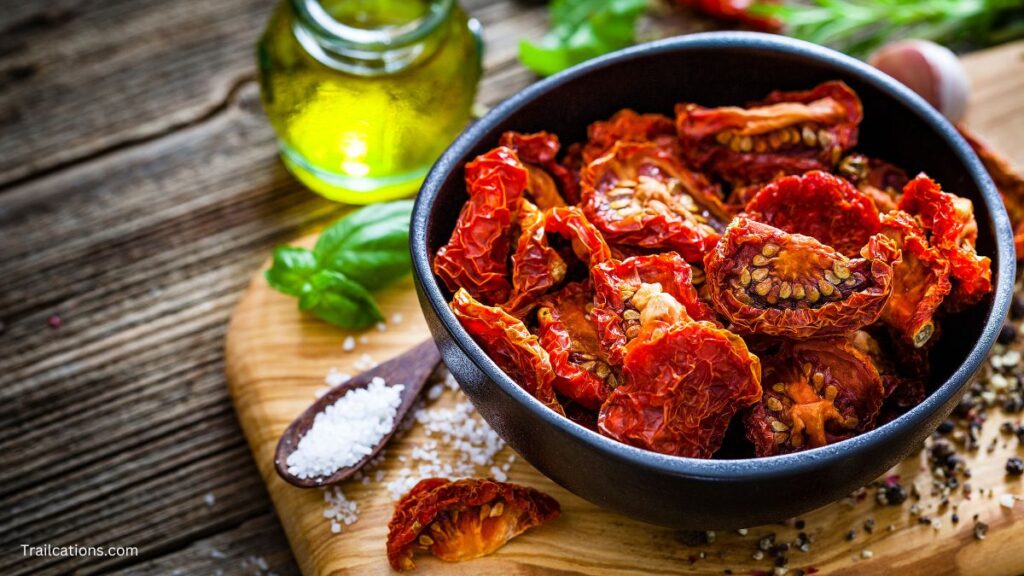
29. Last minute grocery store runs are a thing of the past when you have a pantry full of staple ingredients.
Having dehydrated ingredients like carrots, onions, celery, garlic or green beans on hand for dinner can make your life so much easier after a long day. Save yourself some time and gas money by shopping right at home in your own beautifully stocked dehydrated food pantry.
30. Create delicious dehydrated dog or cat treats for your furry adventure pals.
You might never go back to buying pricey pet treats from the store once you try drying your own. Why? Not only do you avoid the artificial coloring, preservatives and cheap filler ingredients of traditional store bought pet treats, your four-legged friends might become slightly obsessed with homemade treats made with L-O-V-E from their favorite human. Don’t say we didn’t warn you!
31. For all you outdoorsy or busy parents out there, the benefits of dehydrating baby food is a game changer.
Adventuring with babies and toddlers becomes a little easier when you have healthy instant baby food powders on hand, all thanks to your dehydrator. At home it’s important to first boil, bake or steam completely your baby’s favorite mix of veggies or fruits. Puree the produce smooth, then dehydrate and grind the dried flaky puree into powder before storing in an airtight jar or bag. When it’s feeding time, add ¼ cup (60mL) boiling water to 1 tbsp (15g) veggie or fruit powder, stir and let cool before feeding your child. Not only does DIY baby food save you time, money and real estate in your backpack or pantry, it’s so tasty that you might just find yourself sneaking a bite!
32. Raw foodies can rejoice with a nutrient preserving dehydrator.
Dehydrating raw food sounds counterintuitive, right? Think again! Raw foods are those that have not been heated above a certain temperature, preserving the natural state of the food’s nutritional value. This means a raw food diet excludes pasteurized dairy or any cooked grains, meat or seafood. Luckily for raw foodies, the low temperatures and precise drying capabilities of a dehydrator means that a food won’t cook, it’ll just dehydrate! A dehydrator is a must-have tool for raw food enthusiasts wanting to sprout their own grains, make their own raw travel snacks or create delicious dried meals. The benefits of dehydrating food are seemingly endless!
33. No matter what type of diet you’re on, your dehydrator has you covered.
Whether your eating choices are health related, religion based, for weight loss, to be more eco-friendly or just a preference, home dried food is there for you. One of the benefits of dehydrating your own foods is that you control all the ingredients that go into your meals. Putting together dried meals and snacks that meet your dietary needs is blissfully easy with dehydrating. Your ingredients are exactly what you started with – no added preservatives, salts, sugars, allergens or animal products. Dehydrators support all diets no matter whether you’re vegan, vegetarian, flexitarian, gluten free, Kosher, Halal, paleo, keto, plant-based, diabetic, DASH, low FODMAP, SCD, raw food, whole 30, carnivore or follow one of the many other dozens of diets out there.
34. Skip the overpriced backpacking meals and snacks when you can make your own healthier dried food at a fraction of the price!
A quick way to save money is supplementing cheap noodles, quick cooking rice and ancient grains with some dehydrated ingredients. Add some nutrition back in with dehydrated veggies, dried fruits, DIY sauce leathers and ground dried flavor powders. Package these ingredients together and you’ve got yourself some serious lightweight, gourmet backpacking meals that won’t break the bank. If you’re really motivated, feel free cook and dry your own pastas, rice or grains for faster rehydration times. Warning: Your delicious DIY backcountry meals may attract some attention from other hungry hikers. We’ve even had hikers ask to buy our homemade meals off of us! They’re just THAT good. 😉
35. Reduce your transportation footprint by buying local and in-season.
The benefits of dehydrating locally grown food at its peak flavors during harvest time and lowest prices is an environmental win! A stockpile of dehydrated ingredients will help you enjoy your produce even when it’s out of season. You can sleep better at night knowing that your dehydrator is helping you do your part in reducing your carbon footprint. By having a fully stocked pantry of dried foods, out of season produce doesn’t have to ship across continents for you to enjoy year round deliciousness. Do your part for the environment by following the seasons with your dehydrator. Less transportation means fewer greenhouse gases!
36. Dehydrators allow you to dry a variety of food at once.
One of the best benefits of a food dehydrator is all of the trays that come with it. Depending on the number of trays, you could fill up your dehydrator with leftover carrots, greens, celery and zucchini all in one go. To make sure your food is dried at the correct temperature, combine “like with like” (ex: veggies stick with veggies). Fruits, herbs, veggies, nuts and meats all dry at different temperatures. One day you can dehydrate bananas, the next it’s pasta sauce and the next is jerky. Food dehydrators are perfect tools for cleaning out your fridge!
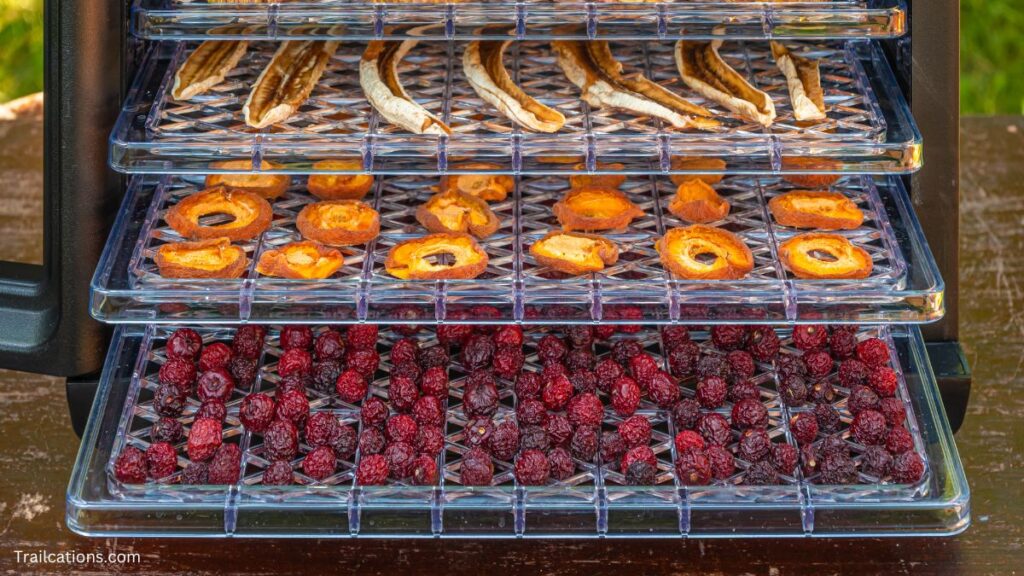
37. Many foods are fabulous to eat in their dried form.
One of the benefits of dehydrating certain foods is that no cooking or rehydrating is required. When hunger strikes, there is no need to spend time heating up water or preparing a meal. Chocolate dipped dried fruit, seasoned veggie chips, trail mixes, DIY granola bars and chewy fruit roll ups are all snacks that can be dried and eaten without cooking. This means more time for adventuring outdoors, relaxing or spending more time with the family.
38. Dehydrating retains more nutrients than other food preservation methods like canning or freezing.
According to USDA research, preserving food by freezing loses 40-60% of nutrients due to ice formation causing cell wall rupture. Canning loses between 60-80% of the original nutrients due the heat required to kill bad bacteria in the preserving process. Dehydration comes out on top with only 3-5% of nutrients lost to the drying process, most of which is Vitamin C. This can be easily prevented by dipping foods in a Vitamin C or citrus juice solution prior to drying. The nutrient-retaining benefits of dehydrating food makes it a clear winner compared to freezing or canning.
39. It’s fun and easy to involve the kids in dehydrating food.
While you might need to have an adult to perform (or supervise) the peeling and slicing tasks, children are fully capable of helping with dehydrating food. From decorating fruit leathers to loading the drying trays with produce, kids can help out with a variety of steps. Plus, it’s a fun way to bond as a family!
40. Dehydrating your food means less waste.
Take those forgotten fruits and veggies in the back of the fridge and stick them in the dehydrator to extend shelf life. One of the benefits of dehydrating food is that you generate less food waste from your kitchen. Instead of tossing out overly ripe produce into the landfill, cut out those blemishes and dehydrate! Pro-tip: Don’t throw out those veggie peels and scraps either! You can dry them and grind them into a healthy vitamin-filled vegetable soup base powder.
41. An amazing amount of different foods can be dehydrated – fresh, canned or frozen.
Sometimes it’s as easy as opening a jar or bag and dumping out the contents onto your drying trays. Hit the “On” button on your dehydrator and walk away! It doesn’t get much simpler than that.
42. You don’t need to spend money on an electric dehydrator to dry your food.
Produce and meats can be dehydrated with varying results in an oven or air fryer. Herbs can be hung in a warm, dry spot in your house to air dry or in a pinch dried in your microwave. There are lots of instructions online on how to build your own solar dryer or make simple hanging baskets for outdoor drying. If you’re asking why you should buy a dehydrator, a great way to get started is drying food in your oven or air fryer. Just make sure your appliance is on the lowest temperature setting!
43. Take advantage of grocery store surplus sales, bulk bargains and farmer’s market low prices.
Buying large quantities of discounted food for your dehydrator means you can save money now and not have to worry about wasting food later. Bulk prices are almost always better than buying a little at a time. Your bank account will thank you!
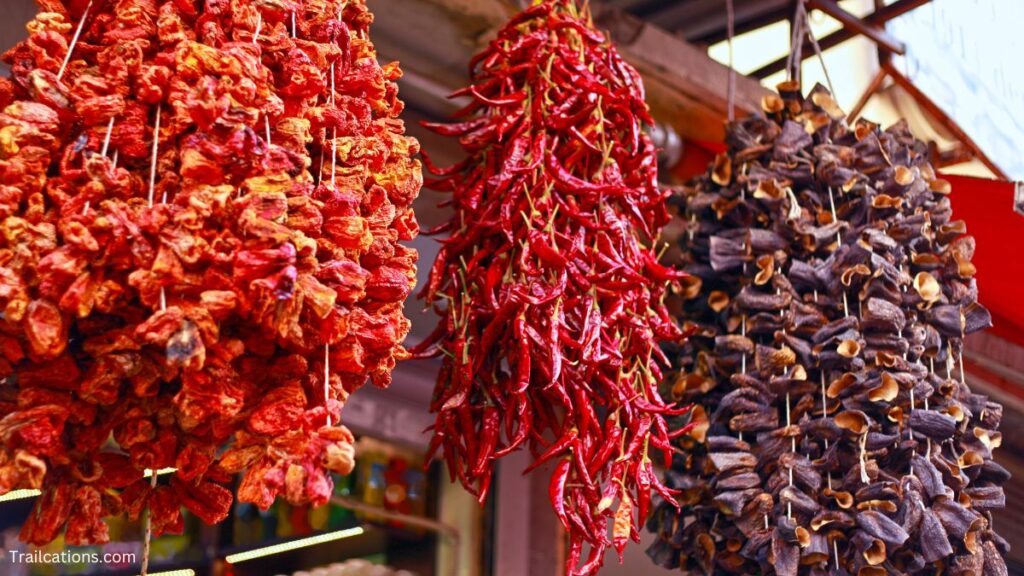
44. Dehydrating is one of the oldest forms of food preservation.
Long before it was hip to “go green,” the first humans used solar and wind energy to dry their meat, fish, grains, seeds, fruits and vegetables. The first electric dehydrator was invented way back in 1795, helping spread the benefits of dehydrating food across the globe. Undoubtedly, these advances in dehydrating brought new cuisines and ingredients across continents, along with best practices. Take advantage of an ancient food preservation process that’s been perfected over millennia by people across the globe.
45. Dried food is perfect to carry on outdoor adventures like hiking, kayaking, canoeing, biking, backpacking and camping.
The less weight you carry on your outdoor adventures, the more distance you can cover. Consequently, packing lightweight and shelf stable food supplies to fuel your adventure is important. On average, dehydrated food has about 1/15 the bulk of the original food item. Dehydrated foods are resilient and it doesn’t matter if a bag of sealed dried food gets jostled around in your pack. Another benefit of dehydrating food is that it is shelf stable which is perfect for going off grid in the backcountry. Bonus: if properly stored in a cool, dark place, dehydrated foods can last anywhere from a few months to a few decades.
46. If picky kids won’t eat their vegetables, it’s easy to secretly add them back into their diet with dried produce powders!
A wonderful benefit of dehydrating food is that pureed veggies can be “hidden” into fruit leathers. Once dehydrated, the texture and taste of the veggies are nearly undetectable. For an extra nutritious boost, dried and powdered veggies can also be sprinkled in mac-n-cheese, sauces, smoothies, popsicles or even baked goods. Hello to some next level parenting pro tips!
47. No electricity is technically required to dehydrate food.
People have dried food for thousands of years using only the power of the sun and wind. Whether you air dry food outdoors in mesh baskets or hang herbs indoors, there is no extra energy required. Being in a hot, sunny and dry environment like a desert helps accelerate the drying process. Even in cloudy climates you can concentrate the power of the sun to dry your food using a DIY or purchased Solar Dryer. The only downside to no electricity is that it might take a few days instead of a few hours for food to fully dry.
48. Dehydrating is a great way to diversify your food storage strategy.
If you’re a prepper, you know better than to put everything in one basket. Drying food is an excellent way to add an extra layer of healthy and delicious food to your long term food storage pantry.
49. The cost savings from dehydrating your own food really adds up.
One of the amazing benefits of dehydrating your own food is the cost savings over store bought food. You can really save some money by drying your own fruit snacks, veggie chips and roll ups. You’ll also save big money with drying garden grown food or bulk produce. At about $1 to run our massive 9 tray dehydrator for 10 hours straight, it’s a pretty reasonable cost to operate our food dryer. The unexpected cost savings we’ve found comes from when end up dehydrating produce from the fridge that we would’ve thrown out and had to buy again. Dehydrating for the win!
